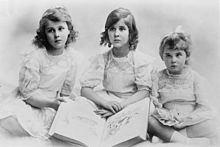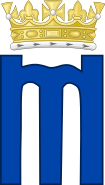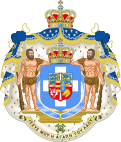Princess Marina of Greece and Denmark
| Princess Marina | |
|---|---|
| Duchess of Kent | |
| File:Princess Marina, Duchess of Kent by Peter North.jpg The Duchess in 1936 | |
| Born | 13 December 1906 Athens, Greece |
| Died | 27 August 1968 (aged 61) Kensington Palace, London, England |
| Burial | 30 August 1968 |
| Spouse | |
| Issue | Prince Edward, Duke of Kent Princess Alexandra, The Hon. Lady Ogilvy Prince Michael of Kent |
| House | Glücksburg |
| Father | Prince Nicholas of Greece and Denmark |
| Mother | Grand Duchess Elena Vladimirovna of Russia |
| Religion | Greek Orthodox Church |
Princess Marina of Greece and Denmark, CI, GCVO, GBE (Template:Lang-el; 13 December [O.S. 30 November] 1906[1] – 27 August 1968) was the daughter of Prince Nicholas of Greece and Denmark and Grand Duchess Elena Vladimirovna of Russia.
In 1934, she married Prince George, Duke of Kent, the fourth son of King George V of the United Kingdom and Mary of Teck.[2] From then on she also became known as the Duchess of Kent. Princess Marina's marriage was the most recent occasion on which a foreign-born princess married into the British Royal Family.
Early life

Princess Marina was born in Athens, Greece, on 13 December 1906.[3] Her father was Prince Nicholas of Greece and Denmark, the third son of George I of Greece.[4] Her mother was Grand Duchess Elena Vladimirovna of Russia, a granddaughter of Tsar Alexander II of Russia.[5] She was the youngest of the couple's children.[6] One of her paternal uncles was Prince Andrew of Greece and Denmark, the father of Prince Philip, Duke of Edinburgh.
She was baptised near the end of 1906, and her godparents were: the King of Greece (her paternal grandfather); the King of the United Kingdom (her great-uncle by marriage); the Princess of Wales; Prince Andrew of Greece and Denmark (her paternal uncle); Grand Duke Boris Vladimirovich of Russia (her maternal uncle); and Grand Duchess Victoria Fyodorovna of Russia (her maternal aunt).[7]
The family was generally poor and forced into exile when she was 11, following the overthrow of the Greek monarchy.[5] They later moved to Paris, while the Princess stayed throughout Europe with her extended family.
Marriage and children

In 1932 Princess Marina and Prince George, Duke of Kent, a second cousin through Christian IX of Denmark, met in London.[5] Their betrothal was announced in August 1934.[4] On 29 November 1934, they married at Westminster Abbey, London.[8] The wedding was followed by a Greek ceremony in the private chapel at Buckingham Palace.[8]
The bride's gown was in white and silver silk brocade, designed by Edward Molyneux, and worked on by a team of seamstresses including, at Marina's request, Russian émigreés.[9]
Her eight bridesmaids were her first cousins, Greek princesses Irene, Eugenie and Katherine, her maternal first cousin Grand Duchess Kira Kirillovna of Russia, Princess Juliana of the Netherlands, her husband's niece Princess Elizabeth of York, her husband's cousins the Lady Iris Mountbatten and Lady Mary Cambridge.[5][10]
The Royal School of Needlework made a quilt as a wedding gift for Princess Marina and the Duke of Kent.[11] Following the marriage she became the Duchess of Kent.
The couple had three children, eight grandchildren, and sixteen great-grandchildren:
- Prince Edward, Duke of Kent (9 October 1935) he married Katharine Lucy Mary Worsley on 8 June 1961. They have three children and ten grandchildren.
- Princess Alexandra, The Hon. Lady Ogilvy (25 December 1936) she married Rt. Hon. Sir Angus James Robert Bruce Ogilvy, son of David Lyulph Gore Wolseley Ogilvy, 7th Earl of Airlie and Lady Alexandra Marie Bridget Coke, on 24 April 1963. They have two children and four grandchildren.
- Prince Michael of Kent (4 July 1942) he married Marie Christine von Reibnitz on 30 June 1978. They have two children and two granddaughters.
The Duke of Kent was killed on 25 August 1942, in an aeroplane crash at Eagles Rock, near Dunbeath, Caithness, Scotland, while on active service with the Royal Air Force. The Duchess, according to royal biographer Hugo Vickers, was "the only war widow in Britain whose estate was forced to pay death duties".[12]
During World War II, Marina was trained as a nurse for three months under the pseudonym "Sister Kay" and joined the civil nurse reserve.[6]
Marina's Private Secretary for many years was Sir Philip Hay KCVO (1918–1986), whose wife Dame Margaret Katherine Hay DCVO (1918–1975) was Woman of the Bedchamber to Queen Elizabeth II and a granddaughter of 1st Duke of Westminster.
Later life and death

After her husband's death, the Duchess of Kent continued to be an active member of the British Royal Family, carrying out a wide range of royal and official engagements.[3] She was the president of the Wimbledon All England Lawn Tennis and Croquet Club for 26 years.[6] She was President of the Royal National Lifeboat Institution from 1943 until her death and was awarded the RNLI's Gold Medal in 1967 to mark this contribution.[13] Her first cousin Prince Philip, Duke of Edinburgh, married her niece, the future Queen Elizabeth II.
In June 1952 the Duchess laid the foundation stone of the new St Mark's Church in Bromley, London, which had been damaged in the war.[14]
In 1952, the Duchess also visited Sarawak (then a British Crown Colony), where she laid the foundation stone of the Cathedral of St. Thomas in Kuching. She also visited the Batu Lintang camp, a Japanese internment camp during World War II which had been converted to a teacher training college, and the town of Sibu, where she opened the outpatient department of the Lau Kheng Howe Hospital.[15]
In March 1957 when the Gold Coast (later Ghana)—gained independence from Britain, the Duchess of Kent was appointed to represent the Queen at the celebrations. Fifty years later, at the 50th Anniversary of Ghana's Independence, it would be her son, Prince Edward, Duke of Kent, who would be appointed by the Queen to represent her.
In September 1966, when the British Protectorate of Bechuanaland became the new Republic of Botswana, the Princess was appointed again to represent the Queen at the celebrations. [16] The main public hospital in Gaborone, the new Botswana's capital, is named "Princess Marina Hospital".
She served as the first Chancellor of the University of Kent at Canterbury from 1963 until her death from a brain tumour at Kensington Palace at 11.40 am on 27 August 1968, aged 61.[3] Funeral service for the Princess was held in the St. George's Chapel on 30 August.[17] She was buried in the Royal Burial Ground, Frogmore.[18] Her funeral was the final royal ceremony attended by her brother-in-law, the former Edward VIII.[19]
Legacy
Princess Marina gave her name to many facilities, including:
- Princess Marina College, Arborfield, Berkshire
- Princess Marina House, a facility of the Royal Air Force Benevolent Fund at Rustington.[20]
- Princess Marina Hospital, Upton, Northamptonshire[21]
- Princess Marina Hospital, Gaborone, Botswana
- Princess Marina Sports Complex, Rickmansworth.[22]
- Duchess of Kent Hospital, Sandakan, Sabah, Malaysia
- Kent College (a teacher training college) Tuaran, Sabah, Malaysia
The diamond and pearl Kent Festoon Tiara was worn by Princess Marina to the 1953 coronation.[23] It then passed to Princess Michael of Kent who has worn it to state banquets.[24][25]
Popular culture
The Kinks recorded "She's Bought a Hat Like Princess Marina" for their 1969 album Arthur (or the Decline and Fall of the British Empire).[26] The song was written by Ray Davies.[26] Princess Marina earned her place in the International Best Dressed List Hall of Fame in 1960 together with Princess Grace of Monaco, Patricia Lopez-Willshaw and Merle Oberon.[27]
She is portrayed by Rita McDonald Damper in the Netflix television series The Crown.
Titles, styles, honours and arms
Titles and styles
- 13 December 1906 – 29 November 1934: Her Royal Highness Princess Marina of Greece and Denmark
- 29 November 1934 – 8 June 1961: Her Royal Highness The Duchess of Kent
- 8 June 1961 – 27 August 1968: Her Royal Highness Princess Marina, Duchess of Kent
At the time of her death, Princess Marina's full style was: Her Royal Highness Princess Marina, Duchess of Kent, Countess of St. Andrews and Baroness Downpatrick, Companion of the Imperial Order of the Crown of India, Dame Grand Cross of the Royal Victorian Order, Dame Grand Cross of the Most Excellent Order of the British Empire, Dame Grand Cross of the Order of St. John of Jerusalem.
Just before the current Duke of Kent's wedding in June 1961 to Katharine Worsley, she announced that she wished to be known as HRH Princess Marina, Duchess of Kent instead of HRH The Dowager Duchess of Kent, a change in traditional style that was granted by her niece, Queen Elizabeth II. Upon her marriage in 1934, Princess Marina had become HRH The Duchess of Kent, Countess of St. Andrews, and Baroness Downpatrick. However, she remained a Princess of Greece and Denmark. Following her elder son's wedding, she simply reverted to her own princely prefix.
Honours
British and Commonwealth honours
- CI: Companion of the Order of the Imperial Crown of India[28]
- GCVO: Dame Grand Cross of the Royal Victorian Order
- GBE: Dame Grand Cross of the Order of the British Empire
- GCStJ: Dame Grand Cross of the Order of St. John of Jerusalem
- Royal Family Order of King George V
- Royal Family Order of King George VI
- Royal Family Order of Queen Elizabeth II
 Canadian Forces Decoration
Canadian Forces Decoration
Foreign honours
 Order of Saints Olga and Sophia, 1st Class[29]
Order of Saints Olga and Sophia, 1st Class[29] Dame Grand Cross of the Order of Beneficence
Dame Grand Cross of the Order of Beneficence Dame Grand Cross of the Order of the Aztec Eagle
Dame Grand Cross of the Order of the Aztec Eagle Dame Grand Cross of the Order of the Sun of Peru
Dame Grand Cross of the Order of the Sun of Peru Dame Grand Cross of the Order of Merit
Dame Grand Cross of the Order of Merit Dame Grand Cross of the National Order of the Southern Cross
Dame Grand Cross of the National Order of the Southern Cross Dame Grand Cross of the Order of the Liberator San Martin
Dame Grand Cross of the Order of the Liberator San Martin Grand Decoration in Gold with Sash for Services to the Republic of Austria[30]
Grand Decoration in Gold with Sash for Services to the Republic of Austria[30]
Honorary military appointments

 Colonel-in-Chief, of The Kent Regiment
Colonel-in-Chief, of The Kent Regiment Colonel-in-Chief, of The Queen's Own Royal West Kent Regiment
Colonel-in-Chief, of The Queen's Own Royal West Kent Regiment Colonel-in-Chief, of The Dorset Regiment
Colonel-in-Chief, of The Dorset Regiment Colonel-in-Chief, of The Essex and Kent Scottish Regiment
Colonel-in-Chief, of The Essex and Kent Scottish Regiment Colonel-in-Chief, of The Devonshire and Dorset Regiment
Colonel-in-Chief, of The Devonshire and Dorset Regiment Colonel-in-Chief, of the Corps of Royal Electrical and Mechanical Engineers
Colonel-in-Chief, of the Corps of Royal Electrical and Mechanical Engineers Colonel-in-Chief, of The Queen's Regiment (Allied)
Colonel-in-Chief, of The Queen's Regiment (Allied)- Honorary Colonel, of the Buckinghamshire Battalion, The Oxfordshire and Buckinghamshire Light Infantry
- Honorary Colonel, of the 4th Battalion, The Oxfordshire and Buckinghamshire Light Infantry
- Honorary Colonel, of the 431 LAA Regiment RA
- Honorary Colonel, of the 299th (Royal Buckinghamshire Yeomanry, Queen's Own Oxfordshire Hussars, and Berkshire) Field Regiment, RA
- Honorary Colonel, of the Buckinghamshire Regiment, RA (Territorials)
- Colonel, of the Queen's Own Buffs
 Commandant, Women's Royal Naval Service (1940-1968) (Chief Commandant from 1951)
Commandant, Women's Royal Naval Service (1940-1968) (Chief Commandant from 1951) Honorary Commandant, of the Women's Royal Australian Naval Service
Honorary Commandant, of the Women's Royal Australian Naval Service
Arms
 |
 |
Ancestry
References
- ^ Genealogy of the Royal Family of Great Britain at the Wayback Machine (archived 28 October 2009)
- ^ "Princess Marina". Oxford dnb. Retrieved 15 June 2013.
- ^ a b c "Marina won Britain's heart". Evening Times. 27 August 1968. Retrieved 17 July 2013.
- ^ a b "Prince Georgei son of King, to be married". The Montreal Gazette. London. CP and AP. 28 August 1934. Retrieved 24 July 2013.
- ^ a b c d "Princess Marina called luckiest girl in the world by relatives". The Milwaukee Journal. Athens. AP. 23 November 1934. Retrieved 24 July 2013.
- ^ a b c "Marina, a tragic but well-loved Princess". The Sydney Morning Herald. London. 28 August 1968. Retrieved 24 July 2013.
- ^ Yvonne's Royalty Home Page — Royal Christenings
- ^ a b "King and Queen see rehearsals". The Sydney Morning Herald. 29 November 1934. Retrieved 24 July 2013.
- ^ "Princess Marina's Gown". Royal Order of Sartorial Splendor.
- ^ "The wedding of Prince George, Duke of Kent and Princess Marina, Duchess of Kent". National Portrait Gallery, London.
- ^ "Princess Marina's quilt". British Pathé. Retrieved 15 June 2013.
- ^ Hugo Vickers, Elizabeth, The Queen Mother, Hutchinson, 2005, p. 230
- ^ Hennessy, Sue (2010). Hidden Depths: Women of the RNLI. The History Press. pp. 140–1. ISBN 9780752454436.
- ^ Robin Waldron. "St Mark's History" (PDF) (2011 ed.). St Mark's Church Bromley. Retrieved 6 April 2015.
- ^ Sarawak Gazette 1952
- ^ Fireworks at Midnight
- ^ "Five Queens at funeral of Duchess". The Windsor Star. Windsor. Reuters. 31 August 1968. Retrieved 24 July 2013.
- ^ "1968: Princess Marina laid to rest". BBC News. 30 August 1976. Retrieved 15 June 2013.
- ^ Ziegler, Philip (1991). King Edward VIII: The official biography. New York: Alfred A. Knopf. ISBN 0-394-57730-2, pp. 554-556.
- ^ "Royal Air Force Benevolent Fund". About Princess Marina House. Retrieved 15 June 2013.
- ^ "Overview - NHS Choices". Princess Marina Hospital. 10 August 2010. Retrieved 17 July 2013.
- ^ "Princess Marina Sports Complex". We Love Rickmansworth. Retrieved 9 April 2012.
- ^ "The Royal Order of Sartorial Splendor: Flashback Friday: Coronation Guests and Their Jewels". Order of Splendor. 2 March 2012. Retrieved 17 July 2013.
- ^ "The place for daily celebrity news". Hello Magazine. Retrieved 15 June 2013.
- ^ "The Royal Order of Sartorial Splendor: Gold Star: Queens with Diplomatic Flair". Order of Splendor. 26 November 2011. Retrieved 15 June 2013.
- ^ a b "She Bought A Hat Like Princess Marina". The Kinks. Retrieved 24 July 2013.
- ^ Ultimate Style - The Best of the Best Dressed List. 2004. ISBN 2 84323 513 8.
- ^ "Viewing Page 3729 of Issue 34406". London Gazette. 8 June 1937. Retrieved 9 April 2012.
- ^ Wedding of Juan Carlos of Spain and Sophia of Greece
- ^ "Reply to a parliamentary question" (PDF) (in German). p. 214. Retrieved 18 October 2012.
See also
- Use dmy dates from April 2012
- Companions of the Order of the Crown of India
- Dames Grand Cross of the Royal Victorian Order
- Dames Grand Cross of the Order of the British Empire
- 1906 births
- 1968 deaths
- People from Athens
- Greek princesses
- Danish princesses
- House of Glücksburg (Greece)
- British princesses by marriage
- House of Windsor
- British duchesses by marriage
- Chancellors of the University of Kent
- Royal Navy admirals
- Women's Royal Naval Service officers
- Deaths from brain tumor
- Deaths from cancer in England
- Dames Grand Cross of the Order of St John
- Grand Crosses of the Order of Beneficence (Greece)
- Grand Crosses of the Order of the Aztec Eagle
- Grand Crosses of the Order of the Sun of Peru
- Grand Crosses of the Order of the Southern Cross
- Grand Crosses of the Order of the Liberator General San Martin
- Recipients of the Grand Decoration with Sash for Services to the Republic of Austria
- Burials at the Royal Burial Ground, Frogmore



